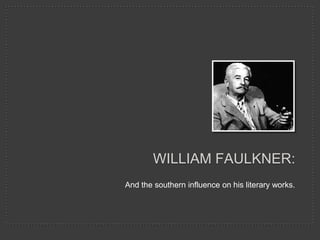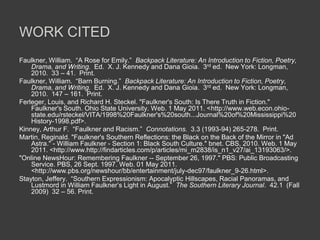William faulkner
- 1. William Faulkner:And the southern influence on his literary works.
- 2. Southern influencesThese influences included:Class discriminationThe landscapeRacismDepiction of charactersTragedy
- 3. Class discriminationSeparation of ClassesâA Rose for EmilyâThe separation of the classes can be seen in âA Rose for Emily,â when it is discussed that Miss Emily would not stoop to marry a âday laborer.âLanguageThe southern way of life is also seen in his works through his characters speaking proper or improper English. The poor southerners speak improper English and the rich southerners speak proper English, as if to separate themselves into their respective classes.
- 4. LandscapeAppalachian MountainsMuch of the south are the foothills for the Appalachian Mountains.The gently rolling hills provide a beautiful landscape for the scenes depicted by Faulkner.However, the hills often provided a higher point of view for the characters.âBarn BurningâAt the end of the story, the climbing of the hill for the boy Snopes shows the internal struggle that he felt regarding the betrayal of his family and his father.
- 5. racismCharacter Underdevelopment. In âA Rose for Miss Emily,â the manservant character is not developed as a character. Even though the manservant plays a vital role in the story, it is as if the manservant is deemed so insignificant that his character is not worth developing or describing in detail. Derogatory, Offensive TermsThe South is known for its deliberate and non-deliberate racism, which influenced Faulkner's perspective.
- 6. Depiction of charactersThe way that Faulkner depicted his characters also influences how readers view the south and the southern peoples.Terms such as, âgauntâ and âpunyâ were used to describe characters.âFaulknerâs novels inaccurately describe the physical attributes of Southerners and this has created false and misleading historical images.â (Ferleger, 362).
- 7. TragedyFaulkner's works are influenced by the southâs tragic past and his works relay that tragedy.âBarn BurningâLater in the story the father is shot after the son reveals the fathers actions. The son will live a life burdened with the thought that his own actions led to the death of his father.âA Rose for EmilyâThe lover is poisoned by Miss Emily so that he could never leave her. It is tragic in the sense that even though her lover will be with her for the rest of her days, he will never show her the love and affection that she longs for because he is dead.
- 8. SummaryThe South influenced Faulkner, but it can also be said that the perception of the South is also influenced by Faulkner. His works are filled with southern themes.I feel that one of the strongest examples of this influence is the racism that is depicted throughout his works.I also see the way the different social classes interact and treat one another. I feel that the southern influence with regard to the separation of the classes is strongly depicted in the type of language spoken by the characters of the different social classes. the southern landscape is used by Faulkner not only as a backdrop for his works, but also to imply the triumphs and setbacks experienced by his characters. The Southâs tragic past is also depicted in Faulkner's works and tragedy is often prevalent in his works.Overall, I believe that the south had a strong influence on shaping the author William Faulkner and his works.
- 9. Work citedFaulkner, William. âA Rose for Emily.â Backpack Literature: An Introduction to Fiction, Poetry, Drama, and Writing. Ed. X. J. Kennedy and Dana Gioia. 3rd ed. New York: Longman, 2010. 33 â 41. Print.Faulkner, William. âBarn Burning.â Backpack Literature: An Introduction to Fiction, Poetry, Drama, and Writing. Ed. X. J. Kennedy and Dana Gioia. 3rd ed. New York: Longman, 2010. 147 â 161. Print.Ferleger, Louis, and Richard H. Steckel. "Faulkner's South: Is There Truth in Fiction." Faulkner's South. Ohio State University. Web. 1 May 2011. <http://www.web.econ.ohio-state.edu/rsteckel/VITA/1998%20Faulkner's%20south...Journal%20of%20Mississippi%20History-1998.pdf>.Kinney, Arthur F. âFaulkner and Racism.â Connotations. 3.3 (1993-94) 265-278. Print.Martin, Reginald. "Faulkner's Southern Reflections: the Black on the Back of the Mirror in "Ad Astra." - William Faulkner - Section 1: Black South Culture." bnet. CBS, 2010. Web. 1 May 2011. <http://www.http://findarticles.com/p/articles/mi_m2838/is_n1_v27/ai_13193063/>."Online NewsHour: Remembering Faulkner -- September 26, 1997." PBS: Public Broadcasting Service. PBS, 26 Sept. 1997. Web. 01 May 2011. <http://www.pbs.org/newshour/bb/entertainment/july-dec97/faulkner_9-26.html>.Stayton, Jeffery. âSouthern Expressionism: Apocalyptic Hillscapes, Racial Panoramas, and Lustmord in William Faulknerâs Light in August.â The Southern Literary Journal. 42.1 (Fall 2009) 32 â 56. Print.








